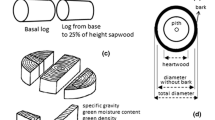Abstract
The chestnut tree (Castanea sativa Mill.) presents good mechanical properties, when valorised in the form of round wood in small diameter. On the other hand, it is very sensitive to cracking during drying. The topic of this study is to optimize a hot oil bath treatment known from previous studies to reduce surface checking. Here, we compare the state of cracks of two series of chestnut tree logs: one is directly dried to 12% moisture content (MC), the other one is treated for one hour using a 130 °C oil bath first, then dried to 12% MC. This first experiment led us to study the evolution of the temperature in the log during the treatment and to propose a chart to determine treatment time in a 130 °C bath. This chart has been successfully tested on a second series of logs.
Zusammenfassung
Kastanienrundholz (Castanea sativa Mill.) besitzt vor allem bei kleinen Durchmessern gute mechanische Eigenschaften, die das Rundholz aufwerten. Andererseits neigt das Holz jedoch während der Trocknung zu Rissbildungen. Ziel der vorliegenden Untersuchung ist die Optimierung einer Heissölbehandlung basierend auf vorherigen Untersuchungen, um Oberflächenrisse zu reduzieren. Die Rissbildung und –entwicklung bei Stammholz wurden anhand zweier Versuchsreihen verglichen: eine Versuchsreihe wurde direkt auf einen Feuchtegehalt von 12% heruntergetrocknet, die andere wurde zuerst einer 130 °C Ölbehandlung unterzogen und anschliessend auf einen Feuchtegehalt von 12% heruntergetrocknet. Aus der ersten Versuchsreihe wurden Informationen über die Temperaturentwicklung im Stamm während der Trocknung gewonnen, um somit eine Vorhersage für die Dauer der 130 °C Ölbehandlung treffen zu können. Diese Ergebnisse konnten in einer zweiten Versuchsreihe erfolgreich angewandt werden.
Similar content being viewed by others
References
Bardet S, Beauchêne J, Thibaut B (2003) Influence of basic density and temperature on mechanical properties perpendicular to grain of ten wood tropical species. Ann For Sci 60:49–59
Beauchêne J (1996) Evolution du comportement du bois vert avec la température – Application à l’étude du déroulage de quelques bois guyanais – Thèse de doctorat de l’Engref en Sciences du bois, dir. Thibaut B, Kourou, Guyane, 166 pages + annexes
Bérard P (2000) Fissuration et autocontrainte dans les bois ronds. LMGC, Montpellier
Bourgeois C (1992) Le châtaignier: un arbre, un bois. Institut pour le développement forestier (Editions), Paris, 367
Dumonceaud O (2001) Petits bois naturellement durables dans des usages extérieurs en vue de limiter l’emploi des traitements par les pesticides - Problèmes posés par l’utilisation du châtaignier (Castanea sativa mill.) et intérêts d’un traitement de type friture à basse température. Thèse de doctorat Montpellier, France, 214
Gril J, Berrada E, Thibaut B, Martin G (1993) Recouvrance hygrothermique du bois vert. I. Influence de la température. Cas du jujubier (Ziziphus lotus L. Lam.). Ann Sci Forest 50:57–70
Gril J, Berrada E, Thibaut B (1993) Recouvrance hygrothermique du bois vert. II – Variations dans le plan transverse chez le châtaignier et l’épicéa et modélisation de la fissuration à coeur provoquée par l’étuvage. Ann Sci Forest 50:487–508
Jullien D (1993) RHT et contraintes de croissance transverses chez le Châtaignier. 6ème Séminaire Architecture, Structure et Mécanique de l’Arbre, CNRS, Montpellier, LMGC, Université Montpellier 2.b
Jullien D (1995) Analyse expérimentale et numérique des contraintes résiduelles dans un matériau élastique orthotrope élaboré par couches successives. Cas d’un disque de bois vert. Thèse de doctorat, Montpellier, Université de Montpellier 2:214
Jullien D, Laghdir A, Gril J (2003) Modelling log-end cracks due to growth stresses: calculation of the elastic energy release rate. Holzforschung 574:407–414
Kübler H (1987) Growth stresses in trees and related wood properties. For Prod Abstr 10(3):61–119
Militz H, Busetto D, Hapla F (2003) Investigation on natural durability and sorption properties of Italian chestnut (Castanea sativa Mill.) from coppice stands. Holz Roh- Werkst 61:133–141
Thevenon MF (2001) Oils and water repellents in wood protection research and development in France – COST conference E22 – Reinbeck, Germany
Author information
Authors and Affiliations
Corresponding author
Rights and permissions
About this article
Cite this article
Berard, P., Laurent, T. & Dumonceaud, O. Use of round wood of chestnut tree coppices: crack risk and effects of a hot oil bath treatment. Holz Roh Werkst 64, 287–293 (2006). https://doi.org/10.1007/s00107-005-0086-4
Published:
Issue Date:
DOI: https://doi.org/10.1007/s00107-005-0086-4




